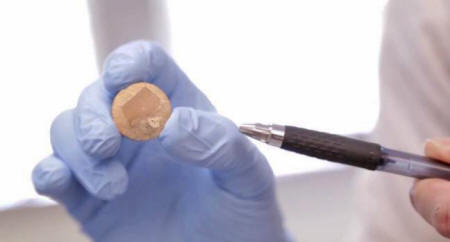|

July 24, 2013
from
ScienceDaily Website
By directing energy beams at tiny
crystals found in a Martian meteorite, a Western University-led team
of geologists has proved that the most common group of meteorites
from Mars is almost 4 billion years younger than many scientists had
believed - resolving a long-standing puzzle in Martian science and
painting a much clearer picture of the Red Planet's evolution that
can now be compared to that of habitable Earth.

By directing
energy beams at tiny crystals found in a
Martian meteorite, a team of geologists has
proved that the most common group of
meteorites from Mars is almost 4 billion
years younger than many scientists had
believed - resolving a long-standing puzzle
in Martian science and painting a much
clearer picture of the Red Planet's
evolution that can now be compared to that
of habitable Earth. (Credit: Image courtesy
of University of Western Ontario)
In a paper published today in the journal Nature, lead author
Desmond Moser, an Earth Sciences professor from Western's Faculty of
Science,
Kim Tait, Curator, Mineralogy, Royal Ontario Museum, and a
team of Canadian, U.S., and British collaborators show that a
representative meteorite from the Royal Ontario Museum (ROM)'s
growing Martian meteorite collection, started as a 200
million-year-old lava flow on Mars, and contains an ancient chemical
signature indicating a hidden layer deep beneath the surface that is
almost as old as the solar system.
The team, composed of scientists from ROM,
the University of Wyoming,
UCLA, and
the University of Portsmouth, also discovered
crystals that grew while the meteorite was launched from Mars
towards Earth, allowing them to narrow down the timing to less than
20 million years ago while also identifying possible launch
locations on the flanks of the supervolcanoes at the Martian
equator.
More details can be found in their paper titled, "Solving the Martian meteorite age conundrum
using micro-baddeleyite and launch-generated zircon."
Moser and his group at Western's Zircon & Accessory Phase Laboratory
(ZAPLab), one of the few electron nanobeam dating facilities in the
world, determined the growth history of crystals on a polished
surface of the meteorite.
The researchers combined a
long-established dating method (measuring radioactive uranium/lead
isotopes) with a recently developed gently-destructive, mineral
grain-scale technique at UCLA that liberates atoms from the crystal
surface using a focused beam of oxygen ions.
Moser estimates that there are roughly 60 Mars rocks dislodged by
meteorite impacts that are now on Earth and available for study, and
that his group's approach can be used on these and a much wider
range of heavenly bodies.
"Basically, the inner solar system
is our oyster. We have hundreds of meteorites that we can apply
this technique to, including asteroids from beyond Mars to
samples from the Moon," says Moser, who credits the generosity
of the collectors that identify this material and make it
available for public research.
Journal Reference
D. E. Moser, K. R. Chamberlain, K. T. Tait, A. K. Schmitt, J. R.
Darling, I. R. Barker, B. C. Hyde.
Solving the Martian meteorite age conundrum
using micro-baddeleyite and launch-generated zircon.
Nature, 2013; 499 (7459): 454 DOI: 10.1038/nature12341
University of Wyoming Researcher’s Techniques
Help Solve...
Martian Meteorites Mystery
July 24, 2013
from
UWYO Website
A University of Wyoming research
professor has helped solve the question of how old Mars meteorites
are and when volcanism actually occurred on the red planet.
Kevin Chamberlain, a research professor in
UW’s Department of
Geology and Geophysics, used newly developed mineral-dating
techniques he created to determine the age of volcanism on Mars at
200 million years ago, as well as the timing of a large-impact event
22 million years ago that launched rocks off the surface of Mars.

Kevin Chamberlain, a
research professor
in UW’s Department of
Geology and Geophysics,
is a co-author of a
paper that appeared in Nature.
Chamberlain used
newly developed mineral-dating techniques he created
to determine the age
of volcanism on Mars at 200 million years ago,
as well as the timing
of a large-impact event 22 million years ago
that launched rocks
off the surface of Mars.
The rocks eventually fell to Earth as
meteorites.
Chamberlain is one of seven co-writers of a research paper, titled “Solving
the Martian Meteorite Age Conundrum Using Micro-Baddeleyite and
‘Launch-Generated Zircon’,” that was published in today’s
issue of Nature, an international weekly journal of science that
publishes peer-reviewed research in all fields of science and
technology.
“The combination of techniques
allowed us to determine the magmatic age of the lava on Mars as
well as the time that the sample was launched into space by a
bolide impact,” Chamberlain says.
“Our results also solved an ongoing
debate about the age of magmatism that most Martian meteorites
appear to have sampled.”
New frontiers
Chamberlain developed the new dating technique at UW with Norbert
Swoboda-Colberg, a lab technician in the UW Department of
Geology and Geophysics, and Susan Swapp, a senior research
scientist, also in geology and geophysics.
The dating technique required the use of a specialized instrument
called a secondary ionization mass spectrometer or
SIMS, of
which only three exist in North America, Chamberlain says.
The
instrument analyzes a mineral sample by excavating microscopic pits
(about 1 micron deep by 20 microns in diameter) in the rock sample
and analyzing the isotopic compositions of the excavated material.
For scale, the diameter of a human hair
is roughly 100 microns, Chamberlain says.
Using a SIMS instrument at UCLA, Chamberlain analyzed 18 different
crystals of the minerals baddeleyite and zircon. All 18 were found
within a 20-millimeter square (roughly three-fourths of an inch)
region of a polished surface of the meteorite. Both minerals are
major reservoirs for uranium in meteorites.
The large crystals are each less than 15 microns in length, too
small to separate physically from the rock. The new dating technique
locates the grains using electron beam imaging instruments, and then
analyzes them in-situ without needing to break the rock apart.
Using the mass spectrometer, Chamberlain measured the ratio of lead
to uranium, which allowed him to calculate the age of the meteorite
grains.
“We solve the (age) conundrum by
determining the degree of shock-induced strain within the
crystals, using in-situ electron nanobeam instruments at the
University of Western Ontario,” he says.
“By combining microstructural
analysis with uranium/lead isotopic measurements in the same
crystals, we established both the age that the rock formed and
the time it was launched off the surface of Mars.”
Chamberlain says both techniques are
relatively non-destructive, which made their use ideal for meteorite
samples. Outside of the excavated pit, the rest of the sample
remained intact.
The project was partially funded through a faculty research grant
Chamberlain obtained from the Wyoming NASA Space Grant Consortium.
Meteorite samples were loaned by the Royal Ontario Museum in
Toronto.
Scientists from UW, the University of
Western Ontario, UCLA and the Royal Ontario Museum collaborated on
the project.
Mars attacks
To date, 65 samples of Martian meteorites have been discovered on
Earth.
Many were found in either Antarctica or the Sahara Desert,
Chamberlain says. In those two places, there are broad
plains with no mountains above the ice or sand - which means that,
if any rock is found on those surfaces, it had to come from space,
Chamberlain explains.
There are many different types of
meteorites, but these 65 have bits of Martian atmosphere trapped
within them, he says.
“The 65 samples are basaltic
compositions,” he says, noting it’s the same material found on
the ocean floor or on the surface of the moon.
“The fact that they’re (meteorites)
all so similar in composition begs the question, because a lot
of Mars is not basaltic. NASA’s rovers are looking at sandstones
for evidence of water and streams, for example. The surface of
Mars has a lot of variety.”
However, the large volcano on Mars is
basaltic in nature.
Other researchers have speculated that many of
the Martian meteorites were a result of a few large bolide impacts
on a lava flow on the flanks of that volcano.
The 200-million-year age of volcanism from these newest research
findings challenges previous research methods that interpret the
ages of ejected igneous crust from Mars to be as old as 4 billion
years, which would mean that the planet’s volcano would have been
extinct for a long time, Chamberlain says.
“The eruption formed the lava. Rocks
crystallized and formed during the volcanic eruption,” he says.
“If we can determine when the rocks crystallized from the lava,
we are dating one of the eruptions of the volcano. Having
evidence that Mars was geologically active fairly recently is a
pretty big deal.”
Chamberlain says the timing of the
large-impact event is between 22 million and 2 million years ago.
“It (the meteorite) hit Mars hard
enough that part of the planet’s surface escaped and entered
interplanetary space,” he says. “During millions of years, some
of it’s been caught by the Earth’s gravity.”
Chamberlain presented results of the
group’s research at an invited talk at the Goldschmidt 2012
International Geochemistry Conference in Montreal last summer, and
at UW’s Department of Physics and Astronomy colloquium this past
spring.
“We plan to apply these techniques
to additional meteorites from Mars, the moon and several
asteroids to gain a better understanding of the evolution of the
solar system,” he says.
|


